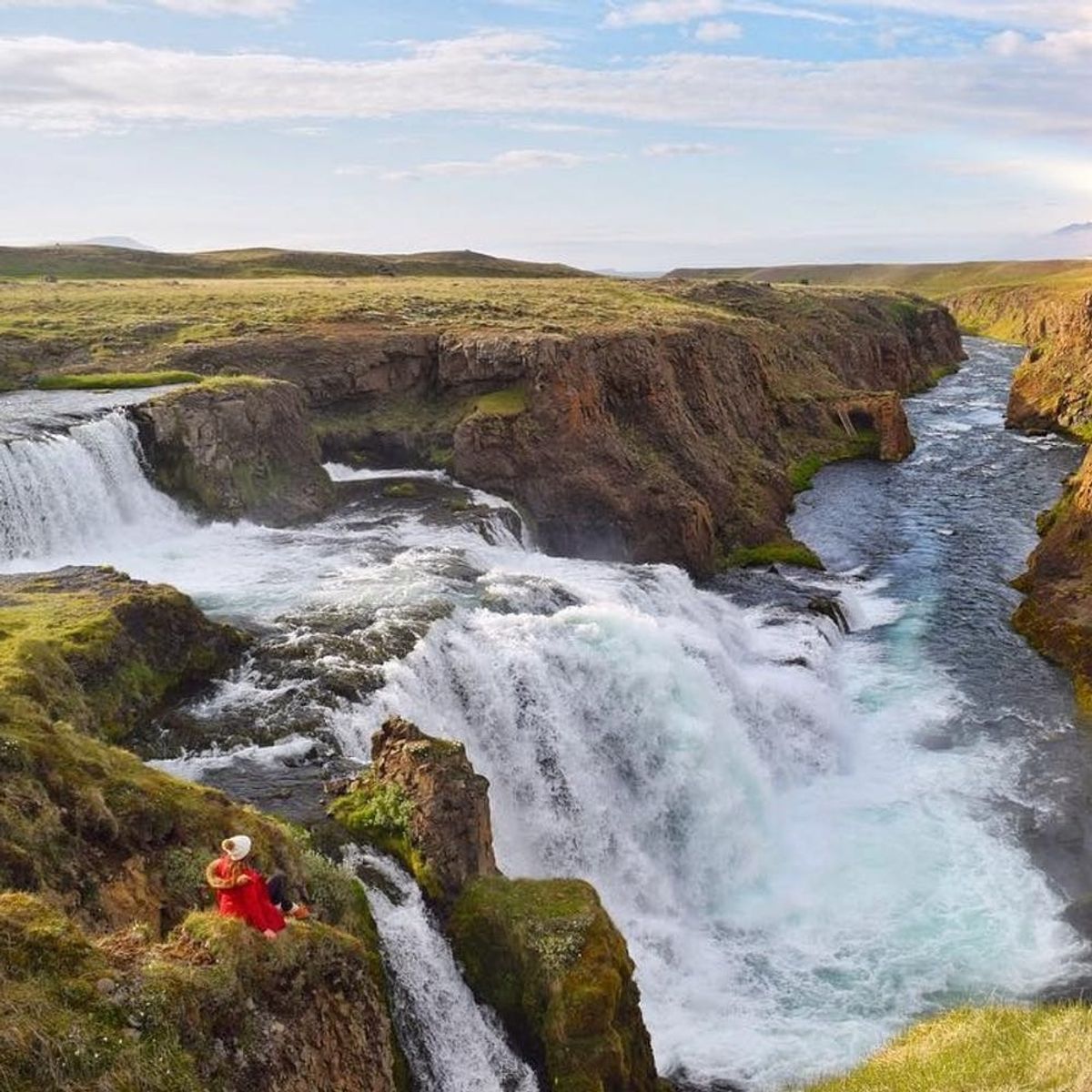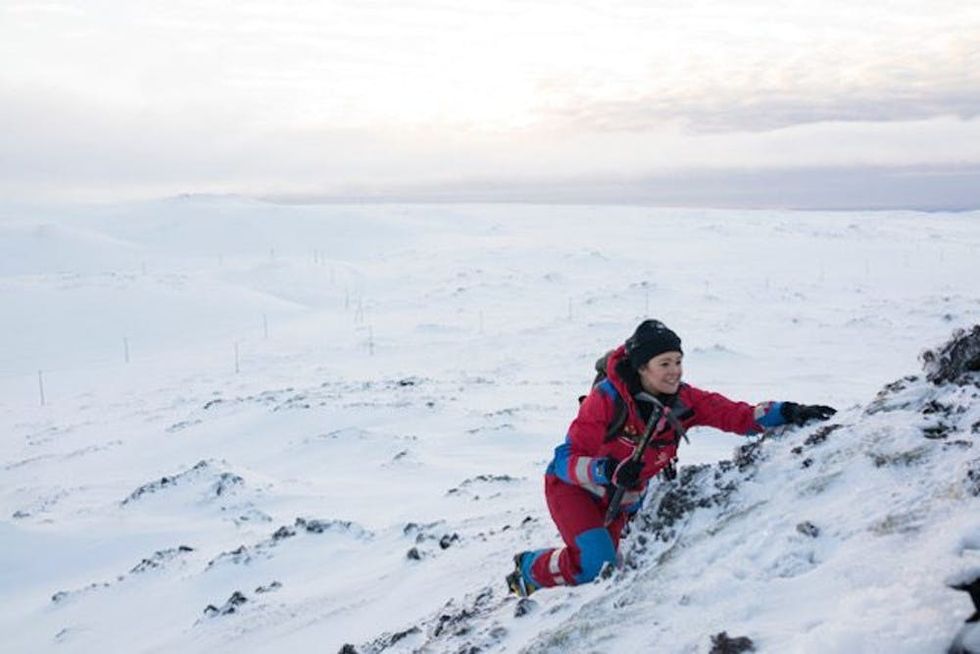Hidden Gems That Will Prove Iceland Truly Is a Magical Place
Lesley Chen is a California native who writes about travel, health/fitness, and other lifestyle topics. She has a serious case of RBF and exercises mainly to balance out an aggressive candy addiction.


Iceland is a country of dramatic extremes and beautiful natural wonders — where else can you explore an ice cave and relax in a natural hot spring in the span of a few hours? It’s no wonder the Land of Fire and Ice has topped many travel bucket lists given its built-in adventure, wellness retreats, and otherworldly landscapes.
If you’ve been itching to experience Iceland yourself, there’s no better time to do it. Summer can bring 24 hours of daylight and hours-long sunsets, and affordable flights and stopover programs have made visiting the tiny island easier than ever. Icelandair’s Stopover program, for instance, offers travelers on their way to Europe a free stop in Reykjavík for up to seven days with no additional airfare, ideal for piggybacking another vacation onto your existing one.
Beyond the popular and Instagram-worthy (read: touristy) Blue Lagoon and Game of Thrones filming locales, the country is full of hidden marvels just waiting to be discovered. Here are three seasoned travelers who share their best off-the-beaten-path tips.
For Adventure Seekers
Guadalupe Laiz is an Aspen-based photographer who first visited Iceland four years ago on a five-day stopover on her way to Paris, and she immediately became captivated by the island and the Icelandic horses that roam it. Eight trips later, she is now working on a coffee table book profiling the majestic animals, Horses of Iceland, along with the country’s official organization (also named Horses of Iceland). She is also starting a photography workshop in Iceland in the fall, helping others capture awe-inspiring sights through a camera lens.
View this post on InstagramA post shared by Guadalupe Laiz (@guadalupelaiz) on
For Laiz, the appeal of Iceland is in its uniqueness. “The landscapes change everywhere you go. In a five-hour drive, you can see waterfalls, icebergs, volcanoes, glaciers, everything. I personally love the people there… They’re very true to themselves. And they take pride in being Icelandic. It’s something beautiful to see, and everyone helps each other there.”
A five-day trip, says Laiz, is enough to just scratch the surface. To truly make the most of a vacation, she recommends spending more time and renting a good 4×4 vehicle to camp along the way and navigate the rough roads. Route 1, or the Ring Road, will take you all around the island, but off-roading inland will let you explore further. Prepare with GPS and apps like TripBucket. You’ll need to drive slowly and be patient, but it’s a tiny island, so “it’s super-easy to get everywhere.” Here are her four must-sees.
View this post on InstagramA post shared by Guadalupe Laiz (@guadalupelaiz) on
1. Visit Landmannalaugar. Landmannalaugar, also known as the People’s Pools, is a mountainous area with an abundance of natural geothermal baths in the center of the island. “GPS will tell you 1.5 hours [to get there], but it will actually take you 2.5 because the roads are crazy,” Laiz says. But once you’ve made it, you’ll be rewarded with plenty of hiking opportunities and natural hot springs. Laiz calls it “the most insane place I’ve ever seen in my entire life,” similar to Rainbow Mountain in Peru, where there are multi-colored peaks. Note to travelers: Landmannalaugar is a place that requires camping. “There are no hotels there; you have to go for an adventure,” she says.
2. Walk the glaciers. There are a number of glaciers in Iceland, with Vatnajökull being the largest, covering eight percent of Iceland’s landmass. Langjökull, the second largest, has a man-made tunnel that gives visitors the unique experience of exploring the inside of the glacier. Laiz cautions that no one should go without a tour guide, as glaciers can be extremely dangerous. To uplevel your experience, she recommends trying to learn a bit of ice climbing.
3. See the Icelandic horses. Naturally, Laiz is an advocate for visiting the infamous horses, which she says are charismatic, colorful, strong, and friendly. “They’ll come to you; they want to be near people,” says Laiz. Though they are shorter than most horses, they are still considered horses and not ponies. (The word “pony” does not exist in Iceland.) The best places to see the horses? “Everywhere.” There are breeders throughout the country — high-end competition horses can cost up to 500K euros and are exported to Europe and the US — and there is a huge breeding farm called Selfoss in the South. Riders of all levels are welcome.
View this post on InstagramIceland #glacierlagoon iceland🇮🇸 #iceland_tourist #icelandtrip #icelandnature #icelandia
A post shared by Guadalupe Laiz (@guadalupelaiz) on
4.See an ice-filled beach.Jökulsárlón Glacial Lagoon, in the south of the island, is a lagoon formed by naturally melting glacier water. The nearby black-sand beach has giant ice chunks on the shore, which has earned it the nickname of Diamond Beach.
For Wellness Buffs
Tessa Torrente is a travel writer and photographer who is constantly looking forward to her next trip by asking, “Where to next?” In 2015, Torrente and her then-fiancée, now-husband decided to get creative with their wedding photos by incorporating their mutual love of travel. Carrying wedding outfits in backpacks, they scouted locations all over Europe and snapped some of the most incredible images you’ll ever see. Torrente now writes about budget and solo travel and has traveled extensively all over the world.
View this post on InstagramA post shared by Travel Writer • Tessa Juliette (@travel_wheretonext) on
1. Find the hidden hot pots. Due to the island’s volcanic activity, hot pots, or geothermal hot springs, can be found all over the island. “The most famous of Iceland’s hot pots is the Blue Lagoon, which has become overcrowded, ‘touristy,’ and expensive,” says Torrente. “But there are many smaller and quieter pots dotted all around the country — most being right off the Ring Road. The best ones are strategically hidden by a boulder or natural cliff, so you have to know where you are going ahead of time. I used Hot Pot Iceland to find a ton of them while driving.”
Torrente’s favorite hot pot is Fosslaug, on the edge of Reykjafoss waterfall, near the town of Varmahlíð. It can be difficult to find, so she created a handy map. The hot pot is only 15 minutes off the main Ring Road, and then a short 10-minute hike from the parking lot. “Do be aware there is a gate you have to cross, but you are not trespassing. The gate is simply to separate the domestic horses owned by the nearby farm from the wild Icelandic horses that roam the countryside.”
In addition to the stunning waterfall backdrop, Torrente says this hot pot is particularly cozy, especially on chilly days. “While most hot pots in Iceland range from fairly hot to lukewarm, this pot is an outlier. It is so hot that in one corner, the water literally bubbles from reaching boiling temperatures.”
2. See the puffins. Iceland is the breeding ground for 60 percent of the world’s Atlantic puffins. A bird enthusiast, Torrente found a spot to see puffins that is both free and away from the crowds. “Most travelers book (expensive) tours, which take you out on large boats to small islands surrounding Iceland. The sights are great but costly. Plus, some boats are so large they scare the birds away or you can’t get too close to them. The spot I found — outside Egilsstaðir in East Iceland — is completely free (!!) and a natural nesting ground for puffins. The walkway was built into the land and does not disturb the birds, who make their nests on the cliffs. While I was there, I saw mothers feeding their babies from less than five feet away. Truly incredible. The actual puffin site is on a small island named Borgarfjarðarhöfn (again outside of Egilsstaðir), and you can view puffins there in June, July, and August.”
3. Touch two different continents at once.Silfra is a fissure between the North American and Eurasian continents, caused by the shifting of the two tectonic plates, which are drifting apart at about two centimeters per year. Water from Langjökull glacier travels underground and is filtered through the lava fields into the crack, creating a crystal clear wonderland. Visibility through the icy blue water is over 300 feet, and incredible snorkeling and diving (wetsuit required) are possible year-round.
View this post on InstagramA post shared by Travel Writer • Tessa Juliette (@travel_wheretonext) on
4. Take a nature-filled detour on West Iceland. Torrente also recommends heading to the Snæfellsnes Peninsula, which is off the main road but is worth the stop for the scenery. Highlights include Snæfellsjökull, a glacier-capped stratovolcano, which featured prominently in Jules Verne’s classic sci-fi novel Journey to the Center of the Earth; the picturesque Kirkjufellsfoss, one of the most photographed waterfalls in Iceland; and Gatklettur, a naturally formed rock arch in the ocean.
For a Local Experience
Unnur Eir Arnardóttir is an Icelandair flight attendant who previously worked as a Stopover Buddy for the airline, a program that matched passengers with Icelandair staff to provide visitors a one-day local experience. Her hobbies include mountaineering, camping, cross-country skiing, and exploring the highlands of her native Iceland. She’s also currently training to become a skydiving instructor.

1. Start the day with a traditional breakfast. Arnardóttir recommends heading to the Mosfellsbakarí bakery in Reykjavík, a family business founded in 1982. The bakery is a favorite among locals and specializes in cakes, pastries, handmade Icelandic chocolates, and fresh coffee. (Photo via Icelandair)
2. Take advantage of the hiking right outside Reykjavík. You don’t have to travel far from the capital to enjoy the great outdoors. Just 20 minutes outside of Reykjavík is Hengill, a volcano in the southwest area. The last eruption was about 2,000 years ago, but the volcano is still active, and the area that surrounds it has high geothermal activity. Near Hengill, you’ll also find Þingvellir National Park, a UNESCO World Heritage Site (Silfra is located there) and where the world’s first democratic parliament was established by the Vikings in AD 930.
Hikers can also head to Mount Esja, which dominates Reykjavík’s skyline and is close enough for a day trip. The mountain is at almost 3,000 feet in height and provides amazing views from the peak.
3. Enjoy some seaside dining. In the Snæfellsnes Peninsula in the West, Hellnar is an old fishing village with a rocky beach; Valasnös, a freestanding rock formation; and the Baðstofa cave refracts light in a way to create a colorful interior. Fjöruhúsid Cafe is a tiny cafe located near the old harbor with homemade dishes like fish soup, fresh bread, pastries, and cakes. It’s also an hour walk from the popular fishing village of Arnarstapi.
4. Do as the locals do. Arnardóttir says to address a local, always refer to them by their first name. “Icelandic people do not have a family name system like the rest of the world, so the first name is what we use both formal and informal. The last name is a combination of the father’s first name (or less common, the mother’s first name) with the ending -son for boys and -dottir for girls.”
Her other tip is to avoid buying plastic water bottles. The tap water is naturally clean; “it has been filtered in the lava for decades,” says Arnardóttir. “Icelandic people are very environmentally friendly, and most wouldn’t ever be caught with a plastic bottle!”
What destinations are on your bucket list? Tag us in your travels on Instagram @BritandCo.
(Featured photo via @travel_wheretonext)
Lesley Chen is a California native who writes about travel, health/fitness, and other lifestyle topics. She has a serious case of RBF and exercises mainly to balance out an aggressive candy addiction.

















